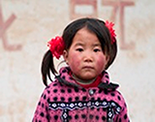Sitting in a pre-fabricated classroom building, 12-year-old student Zhou Xiangkang was happy to resume classes. It is more than two weeks after the 8-magnitute earthquake severely damaged his school on May 12 in Dale Village, Dujiangyan, one of the worst-hit areas.
 ©UNICEF/China/2008/Adam Dean ©UNICEF/China/2008/Adam Dean
Children attend school in a tent classroom in the city of Mianyang in Sichuan Province. UNICEF has provided portable latrines at the temporary school. The city is in one of the areas hardest hit by the earthquake |
"When the earthquake jolted our school building, I was very scared." The fifth grader told UNICEF education officer Ms Guo Xiaoping who was on a mission to assess the educational needs of children in the quake zone. The four-storey building of his school withstood the strong tremor but was left with large cracks in its walls.
It is estimated that more than 10,000 schools are seriously damaged or reduced to rubble in Sichuan province. At least 1.6 million square meters of school building space has been lost. The local education authority plans to resume regular education this August. At present, the graduating junior and senior high school students have resumed regular classes to prepare for university entrance exams. Younger students have only half-day study.
A door that never close for children
"Parents keep sending their children to temporary schools. But the classrooms are quite limited." Mr. Wang Fengxiong, Deputy General Director of Sichuan Education Commission said, "The half-day classes are mainly recreational activities to help the students recover from their traumatic experience."
To cope with the increasing number of students, most schools are operating on double shifts. But they have very limited schooling materials to work with. "From blackboards to textbooks, we need everything to bring back a normal classroom." Wang said.
No official figures are available on how many school aged children are not yet back to school.
Yang Ruoxi, a fifth grader from Xinxing primary school of Pengzhou County could hardly smile for a photo at a celebration get-together for International Children's Day. The twelve year old girl and her classmates haven't yet gone back to school. "I wish that my new (temporary) school will also be open to students from remote areas." She said.
A safe classroom
With steaming hot summer weather on the way, temperatures inside the tents are soaring up to 40℃. The education authority has asked temporary schools to reinforce epidemic prevention, especially through safe water and sanitation.
Mobile toilets are among the most needed supplies in the quake zone. In some temporary shelters, people have to use open-air latrines that are rounded by plastic sheets at four sides or just dig a pit in the ground.
"Hygienic toilets are in dire need as more students are getting back to school." Ms Guo Xiaoping said. "Sometimes, we can just offer the children some soap so that they can wash their hands after defecation and before eating. This will effectively reduce the spread of diseases."
Make schools more child-friendly
"In the aftermath of the disaster, it's essential to provide children a friendly space where they can regain a sense of normalcy." Said Mr. David McLoughlin, UNICEF China's Deputy Representative. He's just returned from an educational assessment mission with Ms. Guo Xiaoping.
The use of Child Friendly Spaces is one of the main UNICEF strategies for ensuring the protection of children in emergency. It is a family and community-based approach to children's well-being that includes health and hygiene, recreation, childcare, psychosocial support and education.
"We are always ready to help bring more children back to school and enjoy their time in school." David said.
By Xu Xin





























